Golfer’s elbow, or medial epicondylitis, is a painful condition affecting the tendons on the inner side of the elbow. It often results from repetitive gripping or twisting motions, commonly seen in golfers and individuals with similar overuse injuries.
Causes and Risk Factors
Golfer’s elbow, or medial epicondylitis, is primarily caused by repetitive strain on the tendons attaching the forearm muscles to the inner elbow. This condition often arises from overuse, such as repetitive gripping, twisting, or throwing motions. Activities like golfing, racquet sports, or manual labor can exacerbate the risk.
The tendons become inflamed due to micro-tears caused by repetitive stress, leading to pain and stiffness. Risk factors include age, with most cases occurring in individuals over 40, and poor technique during physical activities. Additionally, inadequate equipment, weak forearm muscles, or insufficient flexibility can contribute to the development of golfer’s elbow.
- Repetitive gripping or twisting motions
- Overuse in sports or work activities
- Age (more common in individuals over 40)
- Poor technique or equipment
- Weak or tight forearm muscles
Understanding these causes and risk factors is essential for prevention and early intervention, helping to reduce the likelihood of developing this condition.
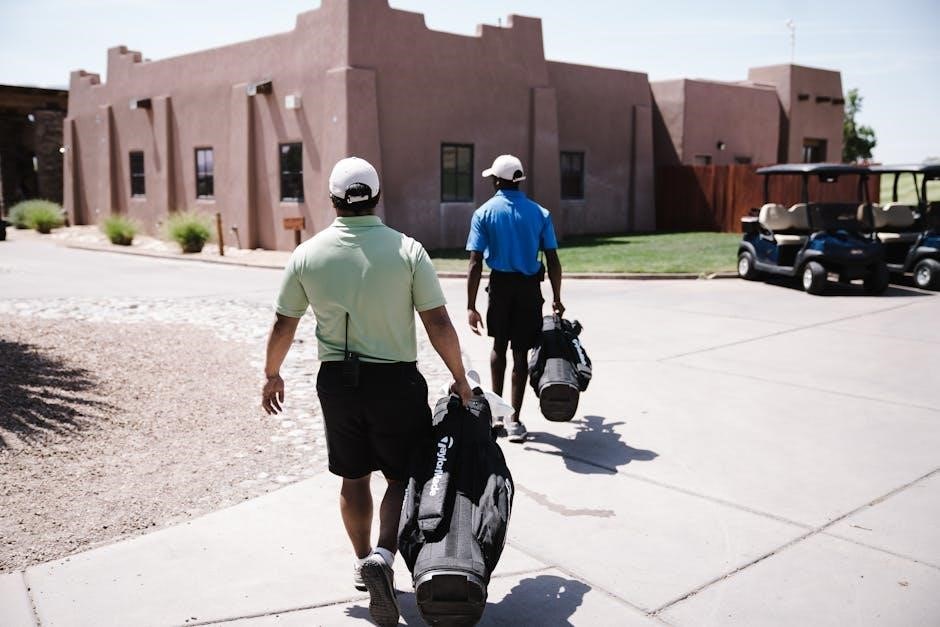
Symptoms
Golfer’s elbow, or medial epicondylitis, typically presents with pain and discomfort on the inner side of the elbow. The pain may radiate to the forearm and is often exacerbated by activities such as gripping, twisting, or lifting.
Common symptoms include tenderness to the touch near the bony bump on the inner elbow, stiffness, and weakness in the affected arm. Patients may also experience numbness or tingling in the fingers, particularly in severe cases.
- Pain on the inner side of the elbow
- Pain during activities like gripping, twisting, or lifting
- Stiffness, especially in the morning
- Weakness in the forearm or hand
- Numbness or tingling in the fingers
These symptoms can vary in severity, ranging from mild discomfort to debilitating pain that interferes with daily activities. If left untreated, the condition may worsen, making it essential to seek medical advice for proper diagnosis and treatment.

Diagnosis
Diagnosing Golfer’s Elbow typically begins with a physical examination and a review of the patient’s medical history. A healthcare provider will assess the elbow for tenderness, swelling, or pain, particularly on the inner side.
A key diagnostic test involves palpation of the medial epicondyle, the bony bump on the inside of the elbow, which is often painful in cases of medial epicondylitis. The provider may also perform specific maneuvers, such as resisted wrist flexion or forearm pronation, to reproduce symptoms.
- Physical examination to assess pain and tenderness
- Palpation of the medial epicondyle
- Resisted wrist flexion or forearm pronation tests
- Imaging studies (e.g., X-rays or MRIs) to rule out fractures or other conditions
While imaging is not always necessary, it may be used to confirm the diagnosis or exclude other causes of elbow pain, such as fractures or arthritis. A proper diagnosis is essential to guide appropriate treatment and prevent further injury.
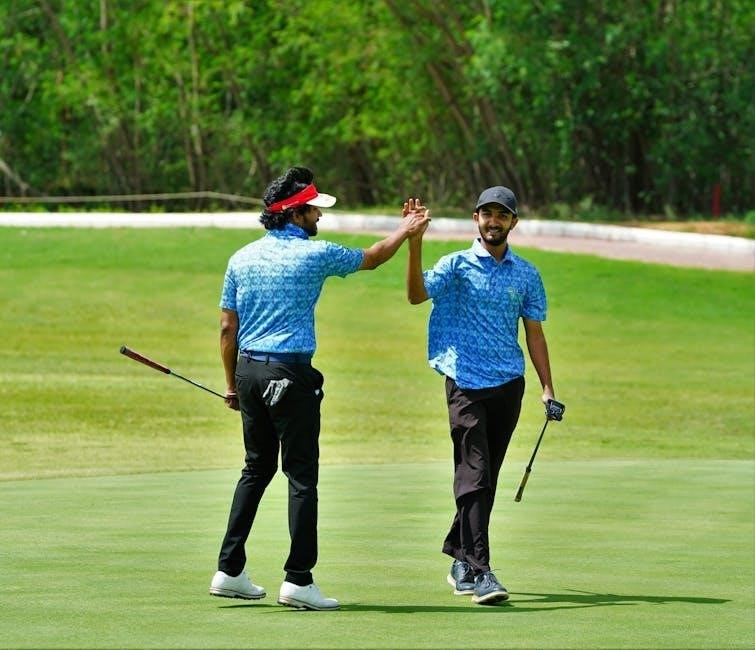
Treatment Options
Treatment for Golfer’s Elbow often involves a combination of rest, ice, and physical therapy. In severe cases, surgery may be necessary. The goal is to reduce pain, inflammation, and restore elbow function.
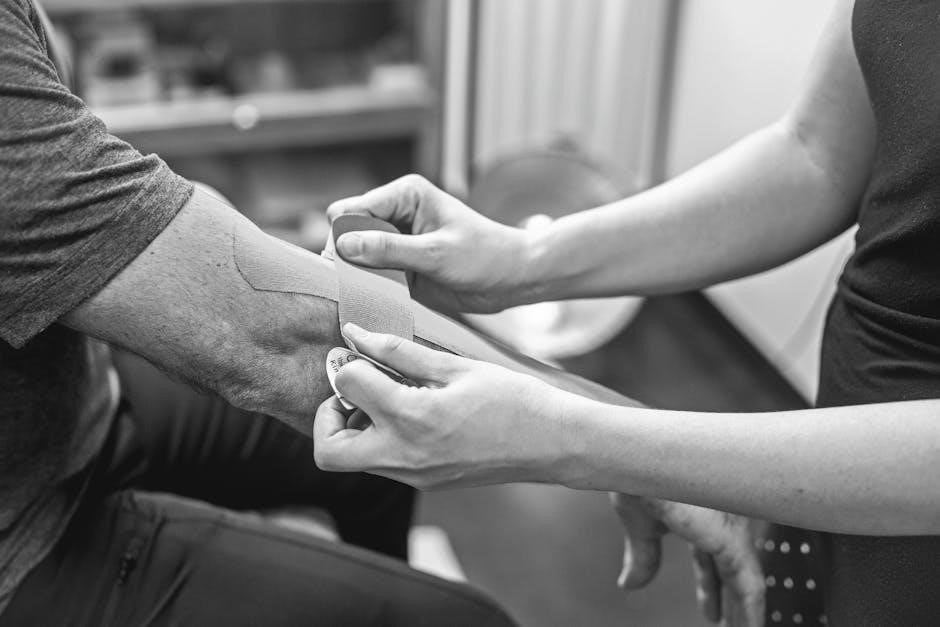
Rest and Ice
Rest and ice are the cornerstone of initial treatment for Golfer’s Elbow. These methods help reduce pain and inflammation, allowing the tendons to heal. Applying ice packs to the affected area for 15-20 minutes, several times a day, can significantly alleviate discomfort. Rest involves avoiding activities that aggravate the condition, such as gripping or repetitive motions. By minimizing stress on the tendons, the body can begin the repair process. Ice therapy, combined with rest, creates an environment conducive to healing and prevents further injury. This approach is often recommended before progressing to more active treatments like exercises or physical therapy.
Physical Therapy
Physical therapy plays a crucial role in the rehabilitation of Golfer’s Elbow, focusing on restoring strength, flexibility, and function to the affected tendons and muscles. A structured program typically includes a combination of stretching and strengthening exercises tailored to address the specific needs of the patient. Stretching exercises target the forearm flexors and wrist flexors, helping to improve range of motion and reduce tightness; Strengthening exercises, such as wrist curls and grip strengthening, are designed to rebuild tendon resilience and muscle endurance. Eccentric exercises, which focus on lengthening muscles under load, are particularly effective for tendon repair. Physical therapy also incorporates manual techniques, such as massage and joint mobilization, to enhance healing and reduce stiffness. Supervision by a licensed physical therapist ensures that exercises are performed correctly and progressively, minimizing the risk of re-injury. By addressing both the symptoms and underlying causes, physical therapy aims to restore normal function and enable a safe return to activities, whether recreational or professional.
Surgery
Surgery is typically considered a last-resort treatment for Golfer’s Elbow when conservative methods fail to provide relief after an extended period, usually 6-12 months. The procedure aims to relieve pain and restore function by addressing the damaged tendons. The most common surgical options include open or arthroscopic release of the affected tendons. During the procedure, the surgeon removes inflamed or scarred tissue and reattaches healthy tendon to the bone. Post-operative care involves immobilization, followed by a gradual rehabilitation program to restore strength and mobility. Risks include infection, nerve damage, and prolonged recovery time. Surgery is generally effective for chronic cases but is not a first-line treatment. Patients are advised to explore all non-surgical options before considering this route. Recovery can take several months, emphasizing the importance of adherence to post-operative rehabilitation protocols. Surgery should only be pursued under the guidance of an orthopedic specialist to ensure optimal outcomes and minimize complications.
Prevention
Preventing Golfer’s Elbow involves proper warm-ups, using suitable equipment, and avoiding repetitive strain. Strengthening forearm muscles and maintaining proper technique in sports can reduce the risk. Regular stretching and eccentric exercises also help prevent recurrence.
Warm-up
A proper warm-up is essential to prevent Golfer’s Elbow and reduce the risk of injury. It prepares the muscles and tendons for physical activity by increasing blood flow and flexibility. Start with 10-15 minutes of light cardio, such as jogging or cycling, to elevate your heart rate and warm up your entire body.
Next, focus on dynamic stretching, which involves moving your joints through a range of motion while keeping your muscles active. Examples include arm circles, wrist extensions, and forearm rotations. These exercises target the muscles and tendons in your elbows and forearms, helping to prevent strain.
Incorporate specific warm-up exercises for your elbows, such as gentle wrist flexor stretches and pronator stretches. Hold each stretch for 20-30 seconds and repeat 2-3 times. Avoid bouncing or forcing the stretch, as this can cause micro-tears in the tendons.
Finally, gradually introduce sport-specific movements, such as practice swings or throws, at a reduced intensity. This allows your muscles and tendons to adapt to the demands of the activity. Consistency is key; perform a warm-up before every practice or game to maintain elbow health and prevent Golfer’s Elbow.
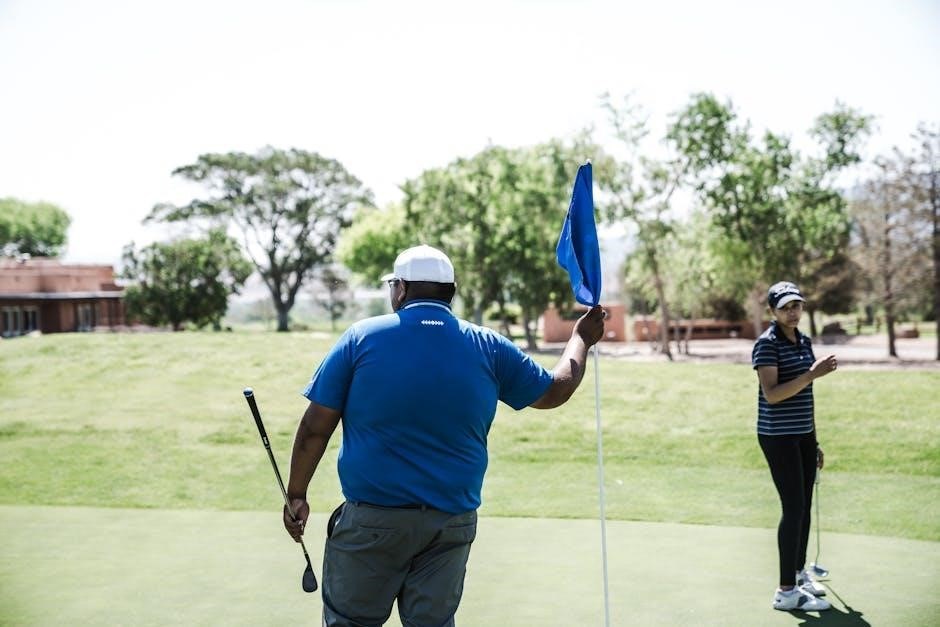
Equipment
Using the right equipment is crucial for effectively performing Golfer’s Elbow exercises and preventing further injury. Start with lightweight dumbbells or resistance bands, which are ideal for strengthening the forearm and elbow muscles without putting excessive strain on the tendons.
- Lightweight dumbbells: These are great for wrist curls and extensions, targeting the flexor and extensor muscles of the forearm.
- Resistance bands: Portable and versatile, resistance bands can be used for eccentric exercises that focus on lengthening the tendons, a key component of Golfer’s Elbow rehabilitation.
- Foam roller: A foam roller can be used for self-myofascial release, helping to reduce muscle tension and improve blood flow to the affected area.
- Brace or sleeve: An elbow brace or sleeve can provide additional support during exercises, reducing strain on the tendons and promoting stability.
Ensure all equipment is of good quality and suitable for your fitness level. Using improper or worn-out equipment can lead to poor form and exacerbate the condition. Always consult with a physical therapist or healthcare professional to confirm the best tools for your specific needs.
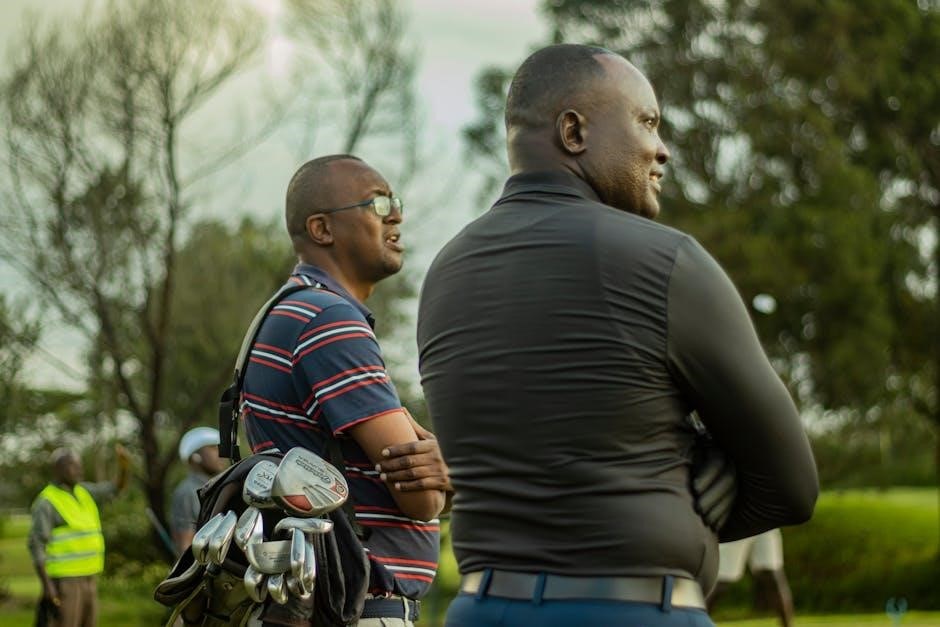
Exercises
Golfer’s Elbow exercises focus on improving flexibility, strength, and tendon health. Key exercises include stretching, strengthening, and eccentric movements to target the forearm and elbow muscles, promoting recovery and preventing recurrence. Always consult a healthcare professional for a personalized program.
Stretching
Stretching is a cornerstone of Golfer’s Elbow rehabilitation, aiming to improve flexibility and reduce tension in the forearm and elbow muscles. One effective stretch involves extending the arm in front of you with the palm down, gently pulling the fingers upward to stretch the forearm. Hold for 20-30 seconds and repeat 3-4 times daily. Another beneficial stretch targets the wrist flexors by placing the arm straight out behind you with the palm up, using your other hand to gently pull the fingers back. This helps alleviate tightness in the tendons connecting to the medial epicondyle. Additionally, incorporating gentle elbow stretches can improve joint mobility and reduce stiffness. It’s important to perform these stretches slowly and without bouncing to avoid further irritation. Regular stretching can help restore normal range of motion and reduce discomfort, making it easier to return to daily activities or sports. Always warm up before stretching to maximize effectiveness and minimize the risk of injury.
Strengthening
Strengthening exercises are essential for rehabilitating Golfer’s Elbow, focusing on the forearm muscles and tendons. A common exercise is the wrist curl, where you hold a light weight with your palm up and slowly lift your wrist, then lower it back down. This targets the flexor muscles on the inner elbow. Another effective exercise involves using a rubber band or resistance band placed over the fingers, with the forearm supported. By stretching the band apart with the fingers, you engage the extensor muscles, which helps balance forearm strength. Forearm pronation and supination exercises, where you rotate the forearm palm-up and palm-down while holding a light weight, also improve muscle endurance. These exercises should be performed with low resistance initially and gradually increased as strength improves. Strengthening helps restore tendon health, reducing pain and preventing future injuries. Consistency is key, with 3 sets of 10-15 repetitions recommended daily. Always warm up before starting and avoid overexertion to promote proper healing and recovery.
Eccentric Exercises
Eccentric exercises are a cornerstone in the rehabilitation of Golfer’s Elbow, focusing on the elongation phase of muscle contractions to strengthen the tendons and muscles; These exercises target the extensor muscles of the forearm, which are often overused and inflamed in medial epicondylitis. A common eccentric exercise is the wrist extensor eccentric stretch, where you start with your elbow bent at 90 degrees and your palm facing down; Slowly lower your wrist against resistance, such as a light weight or resistance band, while keeping your forearm still. This movement emphasizes the lengthening of the extensor muscles, promoting tendon repair and strength. Another effective exercise is the towel twist, where you grip a towel with both hands and twist it in opposite directions, focusing on the eccentric phase of the movement. Eccentric exercises should be performed with controlled movements and low resistance initially, gradually increasing as tolerance improves. These exercises are typically done 2-3 times daily, with 3 sets of 10-15 repetitions. They are particularly beneficial for addressing the degenerative changes in the tendons associated with Golfer’s Elbow, helping to restore function and reduce pain over time.
Core Stability
Core stability exercises play a crucial role in the rehabilitation and prevention of Golfer’s Elbow. Strengthening the muscles of the trunk, including the abdominals and lower back, helps improve posture, balance, and overall athletic performance. A strong core reduces the strain on the elbow joint by promoting proper movement patterns and reducing compensatory motions that can exacerbate medial epicondylitis.
Common core stability exercises include planks, bird dogs, and bridges. Planks engage the transverse abdominis muscle, which is essential for spinal stability. Bird dogs strengthen the deep stabilizers of the spine and improve coordination. Bridges target the glutes and hamstrings, which are often underactive in individuals with Golfer’s Elbow. These exercises should be performed with controlled movements and held for 20-30 seconds to maximize their effectiveness.
Incorporating core stability into a rehabilitation program can enhance the body’s ability to absorb and distribute forces during activities, reducing the risk of overuse injuries like Golfer’s Elbow. By addressing the entire kinetic chain, these exercises help restore proper biomechanics and prevent recurrence of the condition.
Recovery and Rehabilitation
Recovery and rehabilitation from Golfer’s Elbow require a structured approach to restore strength, flexibility, and function to the affected elbow and forearm. The process typically begins with rest and ice to reduce inflammation, followed by a gradual progression of exercises tailored to improve tendon health and muscle balance.
Physical therapy plays a central role in rehabilitation, focusing on stretching and strengthening exercises for the forearm, wrist, and elbow. Eccentric exercises, which target the tendons during the lengthening phase of muscle contraction, are particularly effective in promoting tendon repair and reducing pain. Patients are often advised to perform these exercises consistently, starting with low resistance and gradually increasing intensity as symptoms improve.
Recovery timelines vary, but most individuals can expect significant improvement within 6-12 months with adherence to a well-designed rehabilitation program. It is crucial to avoid rushing back to activities that may aggravate the condition, as premature return can lead to recurrence or prolonged recovery. Patience and consistency are key to achieving long-term relief and preventing future episodes of Golfer’s Elbow.
Complications
If left untreated or improperly managed, Golfer’s Elbow can lead to several complications that may prolong recovery or worsen symptoms. One common complication is chronic pain, which can significantly impact daily activities and reduce quality of life. Persistent inflammation may also cause tendon degeneration, making the condition more challenging to treat.
In severe cases, untreated Golfer’s Elbow can result in a complete rupture of the affected tendons, requiring surgical intervention. Additionally, prolonged immobilization or inadequate rehabilitation may lead to stiffness and reduced range of motion in the elbow and forearm. In some instances, nerve entrapment or irritation may occur, causing numbness, tingling, or weakness in the hand or fingers.
Delayed or insufficient treatment can also lead to recurring episodes of the condition, creating a cycle of injury and inflammation. This underscores the importance of early diagnosis, proper rehabilitation, and adherence to a structured exercise program to prevent long-term complications and ensure a full recovery.
Downloadable PDF Guide
A downloadable PDF guide on Golfer’s Elbow exercises provides a comprehensive resource for understanding and managing the condition. These guides typically include detailed information on the causes, symptoms, and treatment options, with a focus on exercises to stretch and strengthen the affected muscles.
Many PDF guides are developed by orthopedic specialists or physiotherapists, ensuring the content is medically accurate and tailored to promote recovery. They often feature step-by-step instructions for exercises, such as wrist flexor stretches, forearm rotations, and eccentric exercises, which are essential for rehabilitation.
In addition to exercises, these guides may include tips on proper warm-up routines, equipment adjustments, and lifestyle modifications to prevent recurrence. They are designed to be user-friendly, allowing individuals to follow a structured program from the comfort of their home.
Downloading a PDF guide can be particularly beneficial for those seeking a self-directed approach to managing Golfer’s Elbow. It serves as a convenient and accessible tool for both patients and professionals, ensuring consistent progress in recovery and prevention.
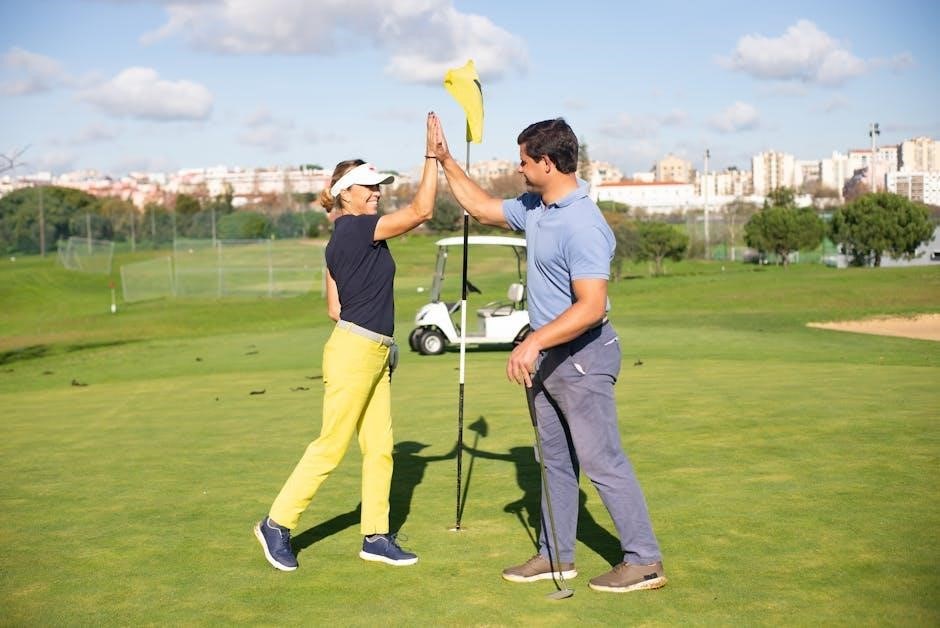
Lifestyle Modifications
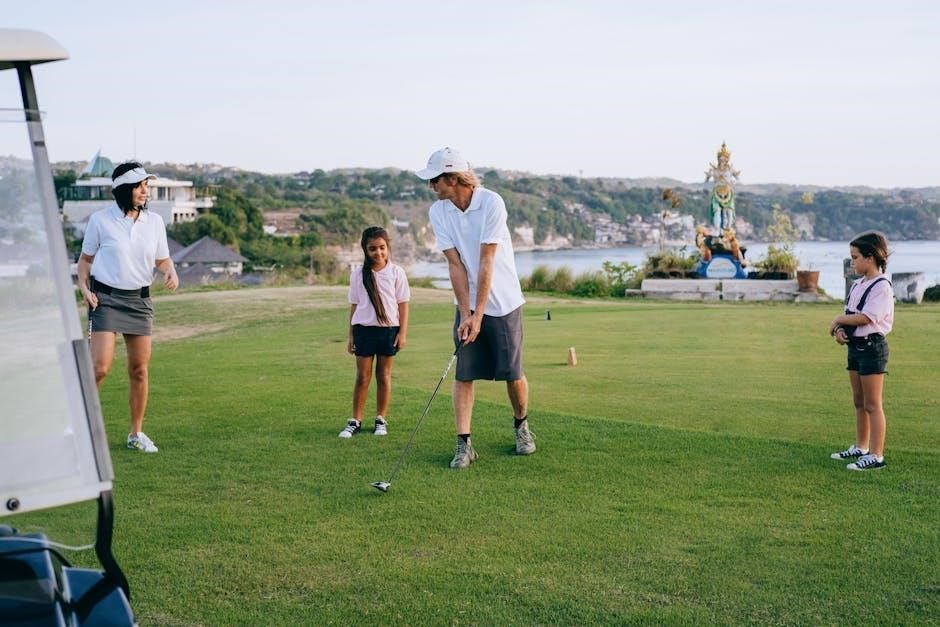
Lifestyle modifications play a crucial role in managing and preventing Golfer’s Elbow. These changes focus on reducing strain on the elbow and forearm, promoting recovery, and avoiding repetitive stress. One key modification is ensuring adequate rest and avoiding activities that exacerbate the condition, such as repetitive gripping or twisting motions.
Improving ergonomics in daily activities and sports is another important aspect. This includes using properly fitted equipment, such as golf clubs or racquets, to reduce strain on the elbow. Additionally, maintaining a healthy weight and engaging in regular exercise to strengthen the forearm and shoulder muscles can help prevent recurrence.
Smoking cessation and managing stress are also beneficial, as smoking can impair tendon healing, and stress can increase muscle tension. Incorporating stretching and strengthening exercises into your daily routine, as outlined in a Golfer’s Elbow exercise PDF, can further support these lifestyle changes. By combining these modifications with medical advice, individuals can effectively manage symptoms and reduce the risk of future episodes.
Golfer’s Elbow, or medial epicondylitis, is a common condition that can significantly impact daily activities and athletic performance. While it often results from repetitive strain or overuse, the good news is that it is highly treatable with a combination of rest, physical therapy, and targeted exercises. The exercises outlined in a Golfer’s Elbow exercises PDF are designed to strengthen the forearm muscles, improve flexibility, and promote tendon healing.
Lifestyle modifications, such as avoiding repetitive gripping motions and ensuring proper equipment fit, can also play a crucial role in prevention and recovery. By incorporating these exercises and adjustments into your routine, individuals can effectively manage symptoms and reduce the risk of recurrence. For those seeking a comprehensive guide, downloading a Golfer’s Elbow exercises PDF provides a structured approach to rehabilitation and long-term elbow health.
Ultimately, addressing Golfer’s Elbow requires a holistic approach that combines medical advice, consistent exercise, and mindful lifestyle changes. With the right strategies, individuals can overcome this condition and return to their normal activities pain-free.
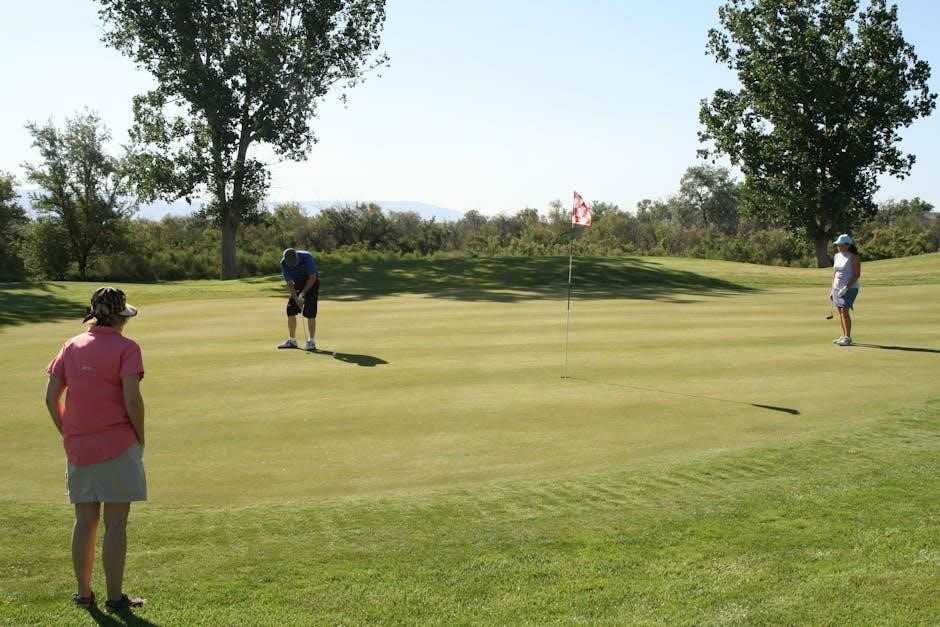
Leave a Reply